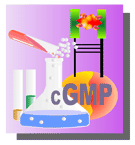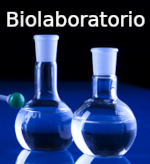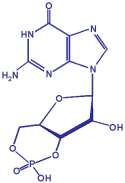
© Blauplanet.com
Other sections:





Cyclic GMP
Advanced
Created by Dr. Luis Agulló (last update on 12-6-2007)
General Scheme of the Pathway

Fig. 1. Cyclic GMP Transduction Pathway. Continuous lines represent real chemical transformation of the compound. Discontinuous lines represent interaction with a target protein (activating it -arrows- or inhibiting it).
Abbreviations:
ANP, atrial natriuretic peptide; Arg, L-arginine; BNP, brain natriuretic peptide; CaM, calmodulin; cGMP, cyclic GMP; CNP, C-type natriuretic peptide; GC-A (GC-B), particulate guanylyl cyclase type A (or type B), the guanylyl cyclase stimulated by natriuretic petides (ANP and BNP bind to GC-A, while CNP binds to GC-B); P, represent a phosphorylated aminoacid that results from cyclic GMP-dependent protein kinase activity; PDE2, PDE3 and PDE5, cyclic nucleotide phosphodiesterases type 2, type 3 and type 5, respectively; PKG, cyclic GMP-dependent protein kinase; sGC, soluble guanylyl cyclase (guanylyl cyclase stimulated by NO and CO).
Cyclic GMP is in the center of the diagram. Above, there are the three different enzymes responsible for its synthesis: soluble guanylyl cyclase and the particulate forms of guanylyl cyclase (GC-A and GC-B). The first type is activated by nitric oxide (NO). The other two types are stimulated by ANP (also by BNP) and CNP, respectively. On the left, the enzymes that synthesize nitric oxide (NOS1, NOS2 and NOS3) are shown, and also two important events for this process: cytosolic calcium increase (that activates constitutive nitric oxide synthases) and uptake of L-arginine (one of the substrates for the synthetic reaction). The metabolism of the natriuretic peptides ANP and CNP is not presented. It can be observed, below cyclic GMP synthesis, the different targets of cyclic GMP: protein kinase G, phosphodiesterases 2 and 3, and other targets not specified here (ion channels modulated by cyclic GMP,...).


Author: Dr. Luis Agulló (luis.agullo [at] lagullo.com).
Edited by Blauplanet.com, Cerdanyola del Vallès, Barcelona, Spain.
Webmaster: info [at] blauplanet.com. Conditions of use.